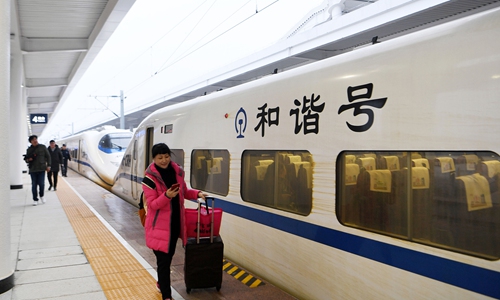HOME >> SOURCE
Yangtze River Delta region sets rail passenger record
By Qi Xijia and Xie Jun Source:Global Times Published: 2019/12/15 20:43:40

Passengers catch a high-speed train leaving from Bozhou, East China's Anhui Province, on Sunday. The train's launch means the operation of the north section of the Shangqiu-Hefei-Hangzhou high-speed railway. China's high-speed railway network will continue to top the world with an estimated length of 35,000 kilometers by the end of this year. Photo: VCG
China's Yangtze River Delta has reportedly set a record in annual railway passenger flows, fueled by the region's nation-leading railway network construction. Experts said that investment in the area's railway networks is likely to speed up further, as refinement of transport facilities would stimulate its integrated development by encouraging talent flows and tourism.On Friday, passenger journeys made via the Yangtze River Delta railway networks broke 700 million so far this year, the first time in history. The region is expected to record 735 million passenger journeys for the whole year, according to a report of news portal xdkb.net on Saturday.
The mileage of railways in operation in the Yangtze River Delta region is expected to total 13,000 kilometers by the end of 2020, with high-speed railway mileage extending to more than 5,300 kilometers, the reported noted.
By that time, China will complete a rapid rail transit network in the area that consists of high-speed railway, normal-speed railway and intercity rail.
China has sought to expand railway networks in the Yangtze River Delta region in the past decade. About 20 high-speed railways have opened in the past 10 years that link cities in the region, such as the high-speed lines between Shanghai and Hangzhou, capital of East China's Zhejiang Province as well as between Nanjing, capital of East China's Jiangsu Province and Hefei, capital of East China's Anhui Province.
On Monday, a high-speed rail that links Xuzhou and Yancheng, two cities in Jiangsu, will also start operation, according to media reports.
China's investment in railway networks in the Yangtze River Delta has fueled the area's economic development, experts said. In the first half of 2019, three cities in the region, Shanghai, Suzhou and Hangzhou, were among the country's 10 wealthiest cities in terms of total GDP rankings.
Expanding the region's railway network also helps the area's integrated development by boosting personnel exchanges and tourism, said Shi Jianxun, a professor at Tongji University.
"As many Yangtze River Delta cities are within a 1.5 hour transportation circle, many people can commute between different cities in the region to study or work," Shi told the Global Times on Sunday.
Jiangsu is striving to achieve the 1.5-hour high-speed railway transport circle by the end of 2020. If successful, most Jiangsu residents can travel to the province's capital city Nanjing within 1.5 hours, according to a report of jschina.com.cn.
Shi said that although the Yangtze River Delta region has a leading role in China in railway construction, as the government pushes the region's integrated development, railway construction will speed up further, such as between Shanghai and some northern Jiangsu cities, to boost talent flows.
Zhao Jian, a professor at the Beijing Jiaotong University, told the Global Times that the Yangtze River Delta integration plan should boost perfection of the "metropolitan railway network", referring to short-distance commuter railways between major cities and adjacent areas.
In early December, China mapped out a plan for the integrated regional development of the Yangtze River Delta to build the area into an economic powerhouse that will add to the country's high-quality development.
Posted in: INDUSTRIES,ECONOMY,BIZ FOCUS